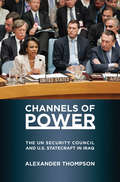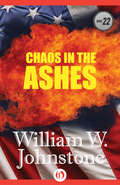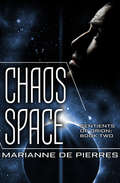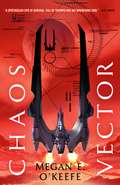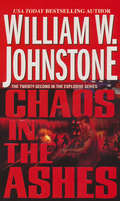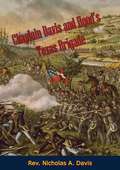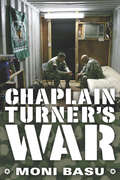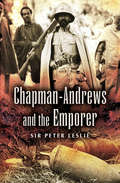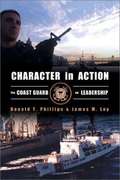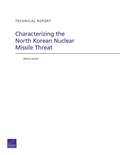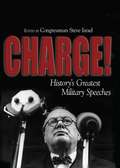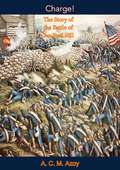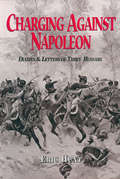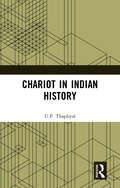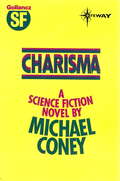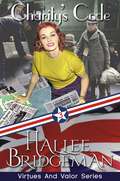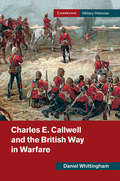- Table View
- List View
Channels of Power: The UN Security Council and U.S. Statecraft in Iraq
by Alexander ThompsonWhen President George W. Bush launched an invasion of Iraq in March of 2003, he did so without the explicit approval of the Security Council. His father's administration, by contrast, carefully funneled statecraft through the United Nations and achieved Council authorization for the U.S.-led Gulf War in 1991. The history of American policy toward Iraq displays considerable variation in the extent to which policies were conducted through the UN and other international organizations. In Channels of Power, Alexander Thompson surveys U.S. policy toward Iraq, starting with the Gulf War, continuing through the interwar years of sanctions and coercive disarmament, and concluding with the 2003 invasion and its long aftermath. He offers a framework for understanding why powerful states often work through international organizations when conducting coercive policies-and why they sometimes choose instead to work alone or with ad hoc coalitions. The conventional wisdom holds that because having legitimacy for their actions is important for normative reasons, states seek multilateral approval. Channels of Power offers a rationalist alternative to these standard legitimation arguments, one based on the notion of strategic information transmission: When state actions are endorsed by an independent organization, this sends politically crucial information to the world community, both leaders and their publics, and results in greater international support.
Chaos In the Ashes (Ashes #22)
by William W. JohnstoneIn the fiery aftermath of apocalypse, America, as we knew it, disappeared-and was reborn as the Tri-States. Under the Rebel law of Ben Raines, there are no slums, no gangs, and no crime. But a new breed of anarchists and malcontents have banded together to destroy everything Ben Raines and his army have risked their lives-and the future of a new America-to build. As devastating civil war turns race against race, brother against brother, and the nation's once-peaceful citizens into a modern-day barbarians, the Tri-States explode in a firestorm of violence and chaos. Now it's up to Ben Raines and his Rebel Army to put the Red, White and Blue democracy back into business...before the red dawn of Armageddon.
Chaos Space (Sentients of Orion #2)
by Marianne de PierresThe second Sentients of Orion novel is &“Space Opera at its best . . . full of the wit and action that we&’ve come to expect from de Pierres&” (The Fringe). As her home planet of Araldis burns following an invasion, Mira Fedor has fled to the nearest Orion League planet seeking aid for her devastated world. But the authorities turn a blind eye, appearing more interested in stealing her bio-ship, Insignia. It is not the only mystery she faces, as she discovers an initiative called Tekton takes extreme measures in acquiring a rare mineral alloy. What has that to do with the destruction of Araldis, or for that sake, the Stain Wars? The truth is bigger than even Mira can fathom, as it begs the larger question: is there a Sole Entity out there in the universe, guiding their every move...? Don't miss the entire Sentients of Orion series: DARK SPACE, CHAOS SPACE, MIRROR SPACE, TRANSFORMATION SPACE.
Chaos Vector (The Protectorate #2)
by Megan E. O'KeefeDazzling space battles, intergalactic politics, and rogue AI collide in the second book in this epic space opera by award-winning author Megan O'Keefe.Sanda and Tomas are fleeing for their lives after letting the most dangerous smartship in the universe run free. Now, unsure of who to trust, Sanda knows only one thing for certain -- to be able to save herself from becoming a pawn of greater powers, she needs to discover the secret of the coordinates hidden in her skull.But getting to those coordinates is a problem she can't solve alone. They exist beyond a dead gate -- a Casimir gate that opened up into a dead-end system without resources worth colonizing, and was sealed off. To get through the dead gate, she needs the help of the enemy Nazca. But some Nazca are only interested in the chip in her head -- and they'll crack her open to get to it.
Chaos in the Ashes (Ashes #22)
by William W. JohnstoneAs a struggling America reemerges from the apocalypse, it descends into a new Civil War in the USA Today–bestselling author&’s dystopian military thriller. In the fiery aftermath of apocalypse, America crumbled to the ground—and was reborn as the Tri-states. Under the Rebel law of Ben Raines, there are no slums, no gangs, and no crime. But a new breed of anarchists and malcontents have banded together to destroy everything Raines and his army have risked their lives to build. As devastating civil war turns race against race, brother against brother, and the nation&’s once-peaceful citizens into modern-day barbarians, the Tri-States explode in a firestorm of violence and chaos. Now it&’s up to Raines and the Rebel Army to bring the Union back together . . . before the American dream is lost forever. Twenty-second in the long-running series!
Chaplain Davis and Hood's Texas Brigade
by Rev Nicholas A. Davis Dr Donald E. EverettPresbyterian minister Nicholas A. Davis joined the Fourth Regiment of Texas Volunteers as chaplain in 1861. Soon after, the unit moved to Virginia, where they fought in the Seven Days Campaign, Second Manassas, Sharpsburg, and Fredericksburg. Rev. Davis wrote his memoir two years into battle, drawing upon keen observational skills and a diary he kept faithfully. He delves deeply into little known topics such as religion in the field, the duties of army chaplains, the appalling condition of wounded men, and war-time Richmond.First published in 1863 and expanded by historian Donald E. Everett in 1962, this present volume has won acclaim from both scholars and history buffs.
Chaplain Turner's War: Life And Faith On The Frontlines With The U. S. Army In Iraq
by Moni BasuAn award-winning journalist portrays life and faith on the frontlines of the Iraq War through the experience of a US Army chaplain. The US mission in Iraq ended Dec. 18, 2011, as the last American soldiers climbed into trucks and headed south through the desert towards Kuwait. Nearly 4,500 American troops died in the Iraq war. More than 30,000 others were physically wounded. Countless others live with scars that can&’t be seen. While medics and doctors heal the physical scars of the wounded, the military employs a select few to heal the hearts, minds, and souls of soldiers—all of whom are changed forever by war. In January 2008, Atlanta Journal-Constitution international reporter Moni Basu began documenting life at war and at home with Darren Turner, a chaplain in the US Army. Chaplain Turner served as the emotional support system of U.S. soldiers more accustomed to toughing it out than opening up. For the first time ever, the entire series of Ms. Basu&’s articles on Chaplain Turner have been collected into one book. There have been few looks into one of this nation&’s most controversial wars that have been as honest, heartbreaking, and inspiring as Chaplain Turner&’s War. The experiences of the young men and women Chaplain Turner served speak with a clarity and force that is relatable to readers of any religion and of any opinion about the Iraq War. It is a story of people&’s lives who are so often taken for granted as steely warriors, and so rarely appreciated as heroes returning home with a lifetime of emotional weight.
Chaplains In Gray: The Confederate Chaplain’s Story
by Charles Frank PittsONE of the oddities of history is that men of peace have never been known to stay out of a fight!There yet remains to be told the story of the chaplains to the men in gray who fought through the bitter years of 1861-1865. Men of war, they stood for him who is called the Prince of peace.In considering the chaplains in the Army of the Confederate States, we are brought face to face with the most amazing display of spiritual power ever witnessed among fighting men on the American continent. We are made aware of the effectiveness of their unique approach to the religious needs of men in uniform. We find tangible proof of the tremendous contribution which religious faith makes to military efficiency. We see the startling results of close co-operation between officers of the line and their spiritual leaders. In the ranks of the Southern armies there appeared a spiritual hunger that could only be assuaged by the uncompromised preaching of the cross. In the valley of the shadow, men of God, loyal to their native states, by precept and example wrote their names among Dixie's men of valor. These chaplains have a message peculiarly fitted for us today--a message of optimism and encouragement.
Chapman-Andrews and the Emporer
by Sir Peter LeslieThis is the previously untold story of the remarkable relationship between a young British diplomat and Emperor Haile Selassie of Ethiopia from the latter’s Coronation in 1930 until his murder in 1975. Based on Chapman-Andrew’s diary, the core of the book describes the extraordinary SOE operation in 1940 to re-instate the Emperor on his throne after being driven out by the invading Italians. Together with the legendary Orde Wingate, Chapman-Andrews accompanied the Emperor through Italian occupied Ethiopia and, after many adventures, the vital mission was accomplished. Later Chapman-Andrews was a key figure during the Suez Crisis and in Britain’s relations with Egypt and Sudan as well as Ethiopia.
Character in Action
by Donald T. Phillips James M. LoyHow does the U.S. Coast Guard create, instill, and maintain leadership throughout a 40,000 member force spread across the United States? A former Commandant of the U.S. Coast Guard and a best-selling author combine their knowledge of the subject to offer a formula for success. Donald T. Phillips, who has written eight books on leadership, asserts that the Coast Guard is a superlative example of an organization with effective leadership, loaded with leaders at all levels. From a guardsman scraping barnacles off buoys in the Gulf of Mexico to the captain of a cutter in the Gulf of Alaska to the Commandant in Washington, they know exactly what leadership is, how it works, and why it is important. This case study in leadership uses the Coast Guard as an example for other organizations who want to imbue leadership to every single one of its members. An effective leadership beacon, the book is replete with tangible examples, vivid anecdotes, and explicit guidelines on how to instill leadership throughout an entire organization. Stories abound on Coast Guard efficiency, innovation, and heroism and many are used to illustrate the service's effectiveness and to engage the reader. From the military and government communities to the business world, a variety of organizations can benefit from this outstanding leadership guide.
Character in Action: The U. S. Coast Guard on Leadership
by Donald T. Phillips James M. LoyHow does the U.S. Coast Guard create, instill, and maintain leadership throughout a 40,000 member force spread across the United States? A former Commandant of the U.S. Coast Guard and a best-selling author combine their knowledge of the subject to offer a formula for success. Donald T. Phillips, who has written eight books on leadership, asserts that the Coast Guard is a superlative example of an organization with effective leadership, loaded with leaders at all levels. From a guardsman scraping barnacles off buoys in the Gulf of Mexico to the captain of a cutter in the Gulf of Alaska to the Commandant in Washington, they know exactly what leadership is, how it works, and why it is important. This case study in leadership uses the Coast Guard as an example for other organizations who want to imbue leadership to every single one of its members. An effective leadership beacon, the book is replete with tangible examples, vivid anecdotes, and explicit guidelines on how to instill leadership throughout an entire,organization. Stories abound on Coast Guard efficiency, innovation, and heroism and many are used to illustrate the service's effectiveness and to engage the reader. From the military and government communities to the business world, a variety of organizations can benefit from this outstanding leadership guide.
Characterizing and Exploring the Implications of Maritime Irregular Warfare
by Peter Chalk Brian Nichiporuk Molly Dunigan Paul Deluca Dick HoffmannAlthough irregular warfare includes a range of activities in which naval forces have played an integral role, there has been little examination of the characteristics or potential of such operations in maritime environments. An assessment of the maritime component of a series of historical and ongoing operations reveals that current notions of irregular warfare would benefit from increased recognition of potentialmaritime contributions.
Characterizing the North Korean Nuclear Missile Threat
by Markus SchillerThe security community generally believes that North Korea has a relatively sophisticated guided ballistic missile program. This report questions this view and seeks to better characterize the North Korean missile threat. The author compares the available data on the North Korean missile program against five hypotheses about the program's origins, sophistication, and scale, highlighting inconsistencies.
Charge!
by Steve IsraelOne of the leading voices on national security issues in the U.S. Congress demonstrates how words have been sharp and powerful weapons of victory in this compilation of great military speeches that helped turn the tide of history. Among the dozens of inspirational speeches featured are: Moses instructing his followers to cross the Jordan River without him. . . Queen Elizabeth pledging to die with her soldiers as they faced the Spanish Armada. . . Patrick Henry choosing between liberty and death. . . Napoleon exhorting his troops as they marched on Egypt. . . Winston Churchill rallying his nation to victory. . . General Sir Montgomery refusing to retreat from Rommel. . . President Roosevelt preparing the American people for World War II. . . General Eisenhower fortifying his troops for the invasion of Normandy. . . President Reagan demanding that Gorbachev tear down the Berlin Wall. . . President George W. Bush encouraging America after 9/11. . . and more.Congressman Israel has included speeches that have motivated and mobilized, challenged and comforted. Some were blurted in the heat of combat, others were carefully written in places far removed from the brutality of the battlefield, but all will inspire readers with the courage that moved people forward against all odds. Each speech is introduced with an insightful historic context. This dramatic sweep of military history in the words of history's military leaders serves to reinforce the concept that the pen is mightier than the sword.
Charge! Hurrah! Hurrah!: A Life of Cardigan of Balaclava (Routledge Library Editions: Military and Naval History #23)
by Donald ThomasFor James Thomas Brudenell, 7th Earl of Cardigan, leading the Light Brigade at Balaclava was but one incident in a life of sensation and notoriety. Donald Thomas’s biography, originally published in 1977, and based on new material when originally published, shows this most controversial Victorian against a panorama of regimental intrigue and aristocratic luxury. Dismissed from the army for ‘revolting’ conduct, Cardigan bought the command of the 11th Hussars (the ‘Cherry Bums’) for £40,000 a few years later. Regimental rivalries led to the ‘Black Bottle’ scandal of 1840 and to a duel in which he shot a brother officer. Charged with attempted murder, Cardigan was the only Victorian peer to be tried by the House of Lords. Nonetheless, his seductions of other men’s wives rivalled his regimental misdemeanours in press reports. He was jeered int he streets, hissed at the theatre and burnt in effigy. It took the glory and the folly of Balaclava to turn ‘this plague-spot of the British army’ into ‘the most popular soldier in England’. Greeted everywhere by cheering crowds, their new hero fought duels and libel actions against those who denied his bravery before the Russian guns. For all his misbehaviour, Cardigan remains warm-blooded, generous, impulsive and courageous, as well as obstinate, proud and sometimes ridiculous. Hated by numerous men, and adored by many women, his elopement with the beautiful Adeline Horsey de Horsey was a triumph of his old age.
Charge! The Story of the Battle of San Juan Hill: The Story Of The Battle Of San Juan Hill (classic Reprint)
by A. C. M. AzoyThe Battle of San Juan Hill of July 1, 1898, also known as the battle for the San Juan Heights, was a decisive battle of the Spanish-American War. The San Juan heights was a north-south running elevation about 2 kilometres (1.2 miles) east of Santiago de Cuba, Cuba. This fight for the heights was the bloodiest and most famous battle of the war. It was also the location of the so called “greatest victory” for the Rough Riders, as stated by the press and its new commander, Theodore Roosevelt, who eventually became vice president and later president of the United States, and who was posthumously awarded the Medal of Honor in 2001 for his actions in Cuba.In Charge! The Story of the Battle of San Juan Hill, Colonel Azoy reconstructs the events of the Battle of San Juan Hill, the climax of the Spanish-American War, a war that so strongly shaped the course of American Development and one that has until now been curiously ignored in the annals of American historical writing.
Charge!: Great Cavalry Charges of the Napoleonic Wars (The Napoleonic Library)
by Digby SmithOne of the leading voices on national-security issues in the US Congress demonstrates how words have been sharp and powerful weapons of victory in this compilation of great military speeches that helped turn the tide of history. Congressman Israel has included speeches that have motivated and mobilized, challenged and comforted. Some were blurted in the heat of combat, others carefully written in places far removed from the brutality of the battlefield, but all will inspire readers with the courage that moved people forward against all odds. This dramatic sweep of military history in the words of history's military leaders serves to reinforce the concept that the pen is mightier than the sword. Congressman Steve Israel represents New York's second district and is a member of the House Appropriations Committee and former member of the Armed Services Committee.
Charging Against Napoleon: Diaries & Letters of Three Hussars
by Eric HuntBy means of the personal diaries and letters of three officers in the 18th Hussars, the reader traces the progress of this famous cavalry Regiment through the gruelling years of campaigning in Portugal, Spain and South West France. The scene then shifts to Northern France and Belgium culminating in the decisive victory at Waterloo. The ferocity of the campaigning in the Peninsula is vividly described by these diarists. Their escapades between and during campaigning make fascinating reading and throw interesting light on military and social conditions at the time.
Charging Against Wellington: The French Cavalry in the Peninsular War, 1807–1814
by Robert BurnhamThis comprehensive military history details the generals, organization and movements of Napoleon&’s cavalry through the Peninsular War. In Charging Against Wellington, historian Robert Burnham draws on primary sources, manuals, memoirs, and regimental histories to reveal the experiences and activities of the French officers and soldiers who fought the British Army in Spain and Portugal. Burnham presents biographies of eighty French generals, focusing on their service in the Peninsula and its impact on their careers. Two become Marshals of France and many were promoted, while others saw their careers damaged in the conflict—including nine who were relieved from their commands. The author then examines the ever-changing organization of the cavalry, including the location and command of the various regiments and brigades. By April 1814, the Peninsula cavalry was down to 4,000 men, a shadow of the force that invaded six years before. Charging Against Wellington chronicles these changes, showing which units left and how their departure impacted the army. Finally, Burnham looks at the service record of the 70+ French cavalry regiments. There is a table for each that tracks the regiment&’s colonels, composition, organization, strength, and casualties while in the Peninsula.
Charging Up San Juan Hill: Theodore Roosevelt and the Making of Imperial America (Witness to History)
by John R. Van Atta“Sheds new light on the history of Theodore Roosevelt and the legendary exploits of his illustrious ‘cowboy’ regiment?the Rough Riders.” —Bonnie M. Miller, author of From Liberation to ConquestAt the turn of the twentieth century, Theodore Roosevelt personified American confidence. A New York City native and recovered asthmatic who spent his twenties in the wilds of the Dakota Territory, Roosevelt leapt into Spanish American War with gusto. He organized a band of cavalry volunteers he called the Rough Riders and, on July 1, 1898, took part in their charge up a Cuban hill the newspapers called San Juan, launching him to national prominence. Without San Juan, Van Atta argues, Roosevelt—whom the papers credited for the victory and lauded as a paragon of manhood—would never have reached a position to become president.In Charging Up San Juan Hill, John R. Van Atta recounts that pivotal assault by Roosevelt and the Rough Riders. Describing the battle’s background and its ramifications for Roosevelt, both personal and political, Van Atta explains how Roosevelt’s wartime experience prompted him to champion American involvement in world affairs. Tracking Roosevelt’s rise to the presidency, this book argues that the global expansion of American influence—indeed, the building of an empire outward from a strengthened core of shared values at home—connected to the broader question of cultural sustainability as much as it did to the increasing of trade, political power, and military might.“Van Atta adeptly links Roosevelt’s deep immersion in Western American culture to his investment in American imperialism in a readable cultural and military history . . . a worthy addition to the shelves of Western historians.” —Western Historical Quarterly
Charging Up San Juan Hill: Theodore Roosevelt and the Making of Imperial America (Witness to History)
by John R. van Van AttaHow Theodore Roosevelt and his Rough Riders exemplified "manhood" and civic virtue.Below a Cuban sun so hot it stung their eyes, American troops hunkered low at the base of Kettle Hill. Spanish bullets zipped overhead, while enemy artillery shells landed all around them. Driving Spanish forces from the high ground would mean gaining control of Santiago, Cuba, and, soon enough, American victory in the Spanish-American War. No one doubted that enemy fire would claim a heavy toll, but these unusual citizen-soldiers and their unlikely commander—39-year-old Colonel Theodore Roosevelt—had volunteered for exactly this kind of mission.In Charging Up San Juan Hill, John R. Van Atta recounts that fateful day in 1898. Describing the battle’s background and its ramifications for Roosevelt, both personal and political, Van Atta explains how Roosevelt’s wartime experience prompted him to champion American involvement in world affairs. Tracking Roosevelt’s rise to the presidency, this book argues that the global expansion of American influence—indeed, the building of an empire outward from a strengthened core of shared values at home—connected to the broader question of cultural sustainability as much as it did to the increasing of trade, political power, and military might.At the turn of the twentieth century, Theodore Roosevelt personified American confidence. A New York City native and recovered asthmatic who spent his twenties in the wilds of the Dakota Territory, Roosevelt leapt into the war with Spain with gusto. He organized a band of cavalry volunteers he called the Rough Riders and, on July 1, 1898, took part in their charge up a Cuban hill the newspapers called San Juan, launching him to national prominence. Without San Juan, Van Atta argues, Roosevelt—whom the papers credited for the victory and lauded as a paragon of manhood—would never have reached a position to become president.
Chariot in Indian History
by U.P. ThapliyalThe invention and development of the chariot around the third millennium revolutionized the art of warfare and dominated the battlefields for some 3000 years. It seems to have evolved in the borderlands between the steppes and the riverlands. It is believed that the Āryan borrowed the idea of chariot from Sumerians around 2000 bc.It is presumed that these Āryans entered Iran and departed in three branches. One marches westward towards Syria, another eastward towards India and a third stays back in Iran. The absence of chariot in Indus valley civilization suggests that chariot arrived in India with Āryans, who settled here around 1500 bc. They used it as a lethal war machine to conquer the natives. The Chariot has played a vital role in Indian warfare through the ages, spanning over Vedic, Epic, and Puranic times, as attested to by literary and archaeological evidence. The Turk invasion marked by the dominance of cavalry arm brought the curtain down on chariot as a war machine. However, it survived in the Indian milieu in some other incarnations.
Charisma
by Michael G. ConeyA secret research station near the Cornish fishing village of Falcombe has discovered the existence of an apparently infinite series of parallel worlds, each a slightly distorted reflection of our own. It has also developed a technique for investigating these worlds; but the only person who can possibly visit and explore a parallel world is the rare individual whose counterpart has lately died there and whose place he can therefore take - which in turn presages his own death on his version of Earth.
Charity's Code, a Novella: Virtues and Valor #3
by Hallee BridgemanThe exciting Virtues and Valor serialized story continues with book 3. DORTHY EWING never met a crossword puzzle that she couldn't solve with shocking speed. As a loving wife and mother of three children, she had an idyllic life with her home and her puzzles - until she had to see her husband off to war. Then the bombing of the Blitz began. Now her husband Tom is a POW in Occupied France, her children have been sent to the hopeful safety of her parents' home in York, and she is working at Bletchley Park as an assistant to cryptanalysts. After cracking the code on an encrypted letter from her husband, she is recruited into a special team called The Virtues. She works on the home-front, receiving and sending messages to her team in France and coordinating a secret mission with her husband via coded letters. She intercepts the transmission from TEMPERANCE alerting to her blown cover. The clock is ticking in a race to save Temperance's life. Information has to be sent to and received from the team on the ground. Can Charity help save her, or will the constraints of time and the efficiency of the Third Reich work against them? CHARITY'S CODE is part three of seven serialized novellas entitled the Virtues and Valor series.
Charles E. Callwell and the British Way in Warfare (Cambridge Military Histories)
by Daniel WhittinghamDaniel Whittingham presents the first full-length study of one of Britain's most important military thinkers, Major-General Sir Charles E. Callwell (1859–1928). It tells the story of his life, which included service in military intelligence, the South African War, and on the General Staff before and during the First World War. It also presents the first comprehensive analysis of his writing: from his well-known books Small Wars (1896) and Military Operations and Maritime Preponderance (1905), to a host of other books and articles that are presented here for the first time. Through a study of Callwell's life and works, this book offers a new perspective on the nature and study of military history, the character of British strategy, and on the army to which he belonged.
